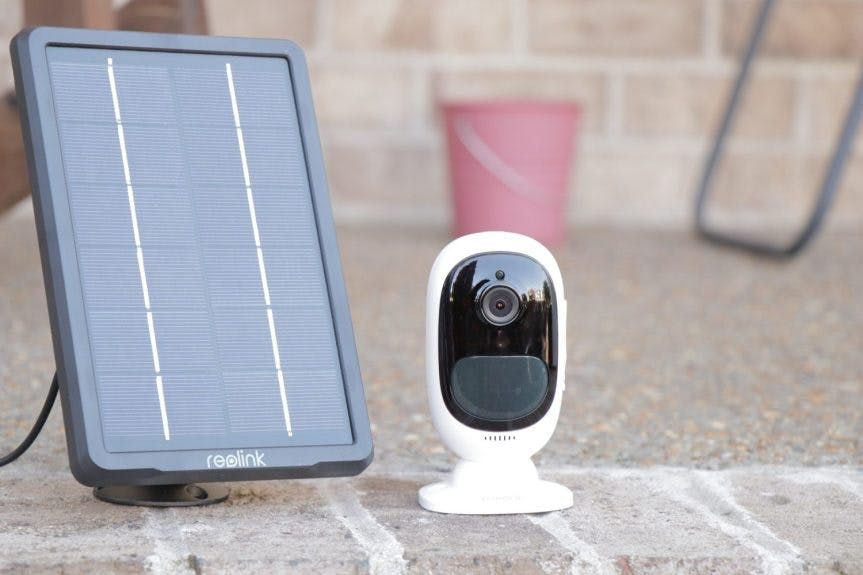
For many years, Arlo has been at the forefront of developing wire-free security cameras. They were one of the first companies to manufacture battery-powered security cameras and they took a big leap when they launched the LTE-enabled Arlo Go. Inevitably, other companies started trying to imitate Arlo’s success including Reolink.
Reolink has consistently launched security cameras similar to that of Arlo’s. In fact, we’ve reviewed both of their indoor/outdoor battery-powered cameras, Reolink Argus and Argus 2, and have noted how similar they are to Arlo Wire-Free and Arlo Pro/Pro 2. This time, we’ll take a look at the newest addition to Reolink’s lineup: Reolink Go. Better still, we’ll compare it to Arlo Go.
1. Setup & Installation
Where They’re The Same
The basics of Reolink Go and Arlo Go are the same. They are both weatherproof, battery-powered cameras designed to withstand harsh outdoor weather conditions. Both are rated IP65, which means their electronic components are sealed shut against dust and water intrusion.
Being both LTE-enabled, Reolink Go and Arlo Go don’t need Wi-Fi to work. They can be placed anywhere there’s an LTE signal, whether in a lake house, construction site, or in the woods. That said, for security, both cameras come with a secure mount that screws the camera into place.
Where They’re Different
Although the same in many ways, Reolink Go and Arlo Go have differences that are in the details. For one, Reolink has a better battery. Where Arlo Go’s rechargeable battery is 3660mAh, Reolink’s battery is 7800mAh. Reolink promises a battery life of up to two months on standby or up to 500 minutes of live streaming and recording.
Both cameras offer an optional solar panel for charging. Reolink’s solar panel sells for $29.99 and is the same one used to power Argus 2. Arlo’s is $79.99 and is the same panel that works with Arlo Pro, Pro 2, and Arlo Security Lights. Arlo Go users can also power their camera continuously using the included power adapter. The catch is that the adapter isn’t weatherproof. Finally, Arlo sells additional rechargeable batteries for $49.99.
Arlo Go also has other advantages over Reolink Go when it comes to setup and installation. For instance, Arlo Go is more rugged. Though both cameras are weatherproof, Arlo Go is more resistant to cold weather. Its operating temperature is -4°F to 113°F whereas Reolink Go can only operate in areas no colder than 14°F.
Finally, Arlo sells skins for Arlo Go in case you want to camouflage your security camera. A set of two skins (black or green) sells for $19.99. A set of two camouflage skins sells for $34.99.
2. Image Quality & Video Features
Where They’re The Same
When it comes to video features, Arlo Go and Reolink Go’s similarities are skin-deep. They are the same in what they can do: stream live videos, offer two-way audio, and provide night vision.
Where They’re Different
Once again, their differences are in the details. In terms of image quality, Reolink Go is superior. Arlo Go can only be configured to stream and record up to 720p videos, whereas Reolink Go supports FHD 1080p.
Reolink Go also uses what they call a Starlight Sensor, which is a CMOS sensor manufactured by SONY. What’s special about it is that it enables Reolink Go to offer “colored night vision” where most cameras (such as Arlo Go) offer black-and-white night vision. We were able to test the Starlight Sensor when we went hands-on with Argus 2 and found that it generates crisp images especially if the subject is within 10 feet of the camera.
3. Security Features
Where They’re The Same
Security is the main focus of both Arlo Go and Reolink Go. When it comes to security features, they both offer motion detection and they take the same course of action when they detect a possible security breach. When motion is detected, Arlo and Reolink are programmed to wake up, record a short clip, and generate an alert, which will be sent to you via email or push notification.
Both cameras use PIR motion sensors. PIR motion sensors detect heat signatures, which means they only trigger when they detect body heat coming from people and animals. Arlo Go’s motion sensor has a detection range of up to 23 feet while Reolink Go’s detection range can go up to 30 feet. It’s worth noting that neither of the two cameras offer intelligent motion detection features (e.g. activity zones, person detection, facial recognition) out of the box. However, Arlo offers Arlo Smart, which is a subscription-based service that will give Arlo cameras extra intelligence.
Where They’re Different
Arlo Go and Reolink Go each offer extra security features. Arlo Go offers sound detection while Reolink Go comes equipped with a siren. Reolink’s siren sounds automatically when motion is detected. Also, you can record a voice message and have the camera play it instead of the siren.
4. LTE Features
Where They’re The Same
Their ability to connect online using LTE signals is what makes Arlo Go and Reolink Go unique. Instead of using Wi-Fi to send alerts, stream videos, or upload recorded clips, the two cameras use LTE powered by a cellular service provider.
Arlo Go and Reolink Go both support multiple service providers, though they mutually recommend AT&T because of its nationwide coverage. However, you must still check which providers offer the strongest LTE signal in your area because the signal strength can greatly affect your camera’s reliability and battery life.
Where They’re Different
The difference between Arlo and Reolink in terms of LTE features is how data plans are offered.
With Arlo, a pre-activated SIM card is included in every purchase. You can choose between AT&T, Verizon, and Arlo’s very own Arlo Mobile. Pricing varies depending on which provider you choose. For example, if you’re an existing Verizon user with a shared data plan, buying a Verizon-powered Arlo Go will add $5 to your monthly bill and it will share in your allotted monthly data. If you are on an unlimited plan, adding Arlo Go will add $20 per month to your bill. Keep in mind that Go will also share in your allotted data. Netgear estimates that the camera will use about 1GB per month.
If you choose the Arlo Mobile Arlo Go, you’ll get a 15-minute capacity free for the first 30 days. That’s 30 seconds of video upload or streaming per day. Once you’ve used up the initial upload data, you’ll need to purchase a monthly data plan starting at $4.99/month.
| $4.99/month | $22.99/month | $32.99/month | |
|---|---|---|---|
| Total Video Upload Capacity | 15 Minutes | 120 Minutes | 225 Minutes |
| Length Of Each Clip | 30 Seconds | 30 Seconds | 30 Seconds |
| Allotted Video Upload Capacity | 1 Clip/Day or 30/Month | 8 Clip/Day or 240/Month | 15 Clips/Day or 450/Month |
With Reolink, it’s up to you to add a SIM card to the camera. For US customers, Reolink recommends picking up an AT&T or T-Mobile SIM card. It’s also your responsibility to get a data plan. The upside of this setup is flexibility. The downside is if left unchecked, the camera’s data usage can easily stack up. That said, we recommend regulating your data use to prevent the camera from going overboard.
5. Video Storage
Where They’re The Same
Finally, we’ll look at how Reolink Go and Arlo Go store videos.
Both cameras support local recording using a microSD card (not included). Reolink Go supports SD cards up to 64GB while Arlo supports cards up to 32GB. Recording videos locally won’t use up any cellular data. However, remotely watching locally saved videos will, so limiting your viewing time is necessary.
Where They’re Different
The two cameras also support cloud recording, but how they do so and what they include is different.
Reolink’s cloud service is still in beta. Currently, they have both paid and unpaid plans. Their free plan offers a 7 day video history but only supports one camera. Beyond that, you can pay for more.
| Basic | Standard | Premier | Business | |
|---|---|---|---|---|
| Price Monthly | $0.00 | $3.49 | $6.99 | $10.49 |
| Price Annually | $0.00 | $34.99 | $69.00 | $104.00 |
| Video History | 7 Days | 30 Days | 30 Days | 60 Days |
| Number of Cameras Supported | 1 | 5 | 10 | 30 |
| Storage Space | 1GB | 10GB | 50GB | 100GB |
On the other hand, Arlo has an existing cloud service structure. You can opt to use the complementary cloud storage service, which provides 7 days of cloud storage and supports five cameras. Both Reolink and Argus have a 1GB storage limit on free plans. If you have more than five cameras or if you need more than 1GB of storage, you can subscribe to Arlo premium cloud services starting at $9.99 per month (30-day storage, 10GB capacity, 10-camera limit). Another major benefit of Arlo’s paid plans is that they include access to Arlo Smart. This service adds activity zones, person detection, package detection, and access to e911.
Final Verdict
While comparing Reolink Go and Arlo Go, we’ve come up with the conclusion that the two are essentially the same in terms of what they can do, but it’s the smallest of details that make the difference. That said, we recommend Arlo Go over Reolink Go. Arlo has more experience making security cameras and it has a better overall track record than Argus.
| Reolink Go | Arlo Go | |
|---|---|---|
| IP Rating | IP65 | IP65 |
| Operating Temperature | 14°F to 131° | -4°F to 113°F |
| Battery | 7800mAh Rechargeable Battery | 3660mAh Rechargeable Battery |
| Other Power Options | Solar Panel (Sold Separately) | Solar Panel (Sold Separately), Power Adapter |
| Optional Accessories | Solar Panel | Solar Panel, Skins, Extra Battery |
| Resolution | 1080p | 720p |
| Night Vision | Colored Night Vision | IR Night Vision |
| Viewing Angle | 130° | 130° |
| Two-Way Audio | ||
| Live Streaming | ||
| Motion Sensor | ||
| Motion Detection Method | PIR | PIR, Arlo Smart |
| Motion Detection Range | 30 feet | 23 feet |
| Sound Detection | ||
| Alerts | Email and Push | Email and Push |
| Other Security Features | Siren, Customizable Voice Alerts | Sound Detection |
| Recommended LTE Service Providers | AT&T, T-Mobile | AT&T, Verizon, Arlo Mobile |
| SIM Card Included | ||
| MicroSD Card | Up to 64GB | Up to 32GB |
| Cloud Storage | 7 Days Free, Premium Options Extra | 7 Days Free, Premium Options Extra |
| Buy Here | Buy Here |

